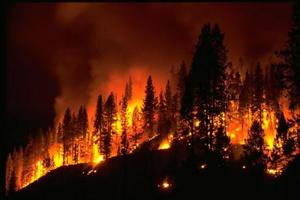WildfiresWildfires to worsen with climate change
Air quality has vastly improved over much of the United States in the past forty years as a result of government efforts to regulate emissions. Gradual climate change may contribute in the coming years to increases in significant, disruptive events like severe storms, floods, and wildfires. A Harvard model predicts wildfire seasons by 2050 will be three weeks longer, up to twice as smoky, and will burn a wider area in the western United States. These increasing wildfires may erase some of the progress made on air quality.

Harvard study claims increase in wildfires due to climate change // Source: fs.usda.gov
Research by environmental scientists at the Harvard School of Engineering and Applied Sciences (SEAS) brings bad news to the western United States, where firefighters are currently battling dozens of fires in at least eleven states.
A Harvard University release reports that the Harvard team’s study suggests wildfire seasons by 2050 will be about three weeks longer, up to twice as smoky, and will burn a wider area in the western states. The findings are based on a set of internationally recognized climate scenarios, decades of historical meteorological data, and records of past fire activity.
The results will be published in the October 2013 issue of Atmospheric Environment and are available in advance online.
Awareness is building that gradual climate change may contribute in the coming years to increases in significant, disruptive events like severe storms and floods. Loretta J. Mickley, a senior research fellow in atmospheric chemistry at Harvard SEAS and coauthor of the new study, is thinking one step further, to secondary effects like forest fires and air quality that rely heavily on meteorological factors.
“We weren’t altogether certain what we would find when we started this project,” Mickley says. “In the future atmosphere we expect warmer temperatures, which are conducive to fires, but it’s not apparent what the rainfall or relative humidity will do. Warmer air can hold more water vapor, for instance, but what does this mean for fires?”
“It turns out that, for the western United States, the biggest driver for fires in the future is temperature, and that result appears robust across models,” Mickley adds. “When you get a large temperature increase over time, as we are seeing, and little change in rainfall, fires will increase in size.”
Reaching that conclusion with statistical confidence required months of analysis, because at the local level, wildfires are very difficult to predict.
“Wildfires are triggered by one set of influences — mainly human activity and lightning — but they grow and spread according to a completely different range of influences that are heavily dependent on the weather,” says lead author Xu Yue. “Of course, when all the factors come together just right — whoosh, there’s a big fire.”
By examining records of past weather conditions and wildfires, the team found that the main factors influencing the spread of fires vary from region to region. In the Rocky Mountain Forest, for example, the best predictor of wildfire area in a given year is
